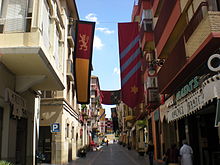Caspe
| Caspe municipality | ||
|---|---|---|
| coat of arms | Map of Spain | |

|
|
|
| Basic data | ||
| Autonomous Community : | Aragon | |
| Province : | Zaragoza | |
| Comarca : | Bajo Aragon-Caspe | |
| Coordinates | 41 ° 14 ′ N , 0 ° 2 ′ W | |
| Height : | 150 msnm | |
| Area : | 503.33 km² | |
| Residents : | 9,748 (Jan 1, 2019) | |
| Population density : | 19.37 inhabitants / km² | |
| Postal code : | 50700 | |
| Municipality number ( INE ): | 50074 | |
| administration | ||
| Mayoress : | María Pilar Herrero Poblador ( PP ) | |
| Website : | www.caspe.es | |
Caspe is a Spanish city in the province of Zaragoza in the autonomous region of Aragon . It is the capital of the Comarca Bajo Aragón-Caspe , but no longer belongs to the Catalan-speaking part of the Franja de Aragón . The place had 9,748 inhabitants on January 1, 2019. The city is located 104 km southeast of Saragossa near the mouth of the Guadalope in the Ebro , which is dammed here by the reservoir of Mequinenza . The annual mean temperature is 14.6 ° C, the annual rainfall 325 mm; this makes it one of the driest places in Aragón.
history
Contrary to a widespread tradition, the place name is likely to go back to the Arabic “kasba”. The place, already inhabited by an Iberian tribe in prehistoric times, was annexed to the Kingdom of Aragon after the reconquest of the Moors in 1169 by King Alfonso II (Aragón) . The place was under the rule of the Johanniter . In 1412, the compromise of Caspe on the succession in Aragon was made in Caspe . In the Guerra dels Segadors (1640-1652) the place was the target of attacks by Franco-Catalan troops. The War of the Spanish Succession (1701–1711) represented Caspe differently than the neighboring towns the cause of the Bourbons. During the Carlist Wars , Caspe sided with Queen Isabella II. During the Spanish Civil War , Caspe was the seat of the Republican Aragonese government.
Population development since 1900
| 1900 | 1910 | 1920 | 1930 | 1940 | 1950 | 1960 | 1970 | 1981 | 1991 | 2001 | 2008 |
|---|---|---|---|---|---|---|---|---|---|---|---|
| 7,808 | 8,893 | 9,259 | 9,992 | 9,844 | 10.128 | 9,603 | 9,162 | 8,339 | 8,029 | 7,896 | 8,848 |
economy
The city's economy is characterized by arable farming (olives, irrigation, especially with cherry plantations) including processing plants, the service sector and industrial assembly as well as textile processing. Adidas maintains a central warehouse for Spain in Caspe. Livestock breeding also plays a role. The city includes the four industrial areas El Castillo , El Portal , Cabezo Mancebo and Los Arcos . In autumn, Caspe holds the Expocaspe trade fair, the Naupesca exhibition and a coin and stamp salon . Increased efforts are being made in the tourism sector.
Attractions
- Neolithic cave paintings
- Roman mausoleum of Miralpeix, moved to the city center after the Ebro was dammed
- Romanesque hermitage of Santa Maria de Horta , moved to the mountain after the damming
- Calle Barrio Verde in the former Jewish quarter ( judería )
- The Santa Maria la Mayor church in the city center, a national monument since 1907, partially destroyed in 1936
- Torre de Salamanca from the last Carlist War with a wide view and heraldic museum
- Plaza Mayor in the center
Personalities
- Domenico Cubelles (1497–1566), Bishop of Malta
- Miguel Agustín Príncipe (1811–1863), writer
- Manuel Buenacasa Tomeo (1886–1964), anarcho-syndicalist
- José María Albareda (1902–1966), university professor
- Sebastián Cirac Estopañán (1903–1970), philologist
- Luís Andrés Edo (1925–2009), resistance fighter
- Alberto Portera (1928–2019), neurologist and art historian
Town twinning
Web links
- Caspe municipality
- Caspe. In: Gran Enciclopedia Aragonesa (Spanish)
Individual evidence
- ↑ Cifras oficiales de población resultantes de la revisión del Padrón municipal a 1 de enero . Population statistics from the Instituto Nacional de Estadística (population update).



